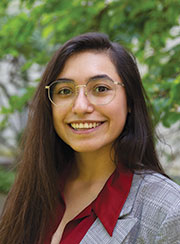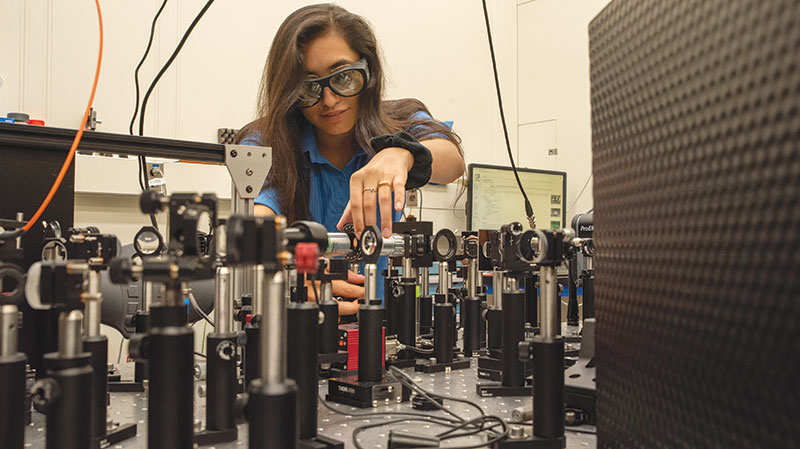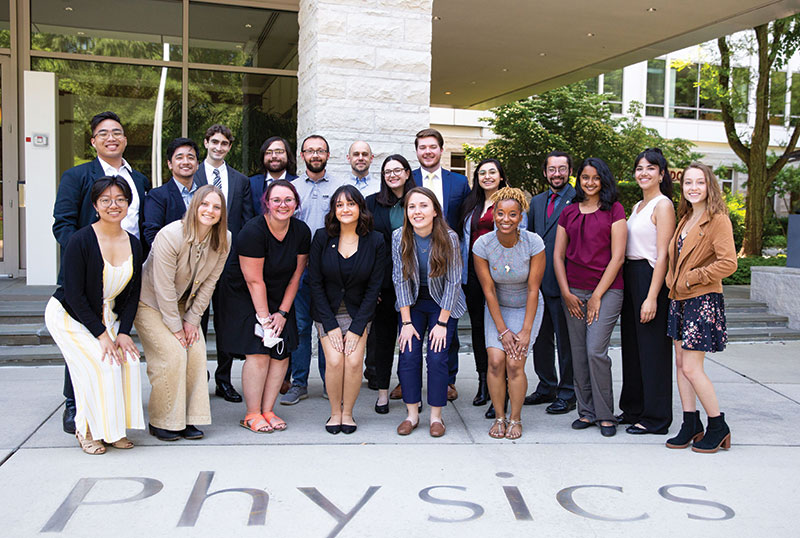What’s a Physicist? My Summer as a Student Intern at NIST
Fall
2022
Feature
What’s a Physicist? My Summer as a Student Intern at NIST
Valeria Viteri-Pflucker, 2022 SPS-NIST Summer Intern and Graduate Student, University of Rochester
 At the age of 13, I had firmly decided that I wanted to be a particle physicist, whatever that meant. All I knew is that I wanted to play with subatomic particles and was particularly fascinated by the idea of antimatter. Whenever I’d tell my parents or friends this goal, they’d inevitably ask what a particle physicist does, since they’d never met one. Amusingly enough, I didn’t really know either, but that didn’t matter.
At the age of 13, I had firmly decided that I wanted to be a particle physicist, whatever that meant. All I knew is that I wanted to play with subatomic particles and was particularly fascinated by the idea of antimatter. Whenever I’d tell my parents or friends this goal, they’d inevitably ask what a particle physicist does, since they’d never met one. Amusingly enough, I didn’t really know either, but that didn’t matter.
Fast-forward to where I am now. I earned a bachelor’s degree in physics from Illinois Wesleyan University in May, and this fall, I am beginning my graduate journey with a PhD program in optics at the University of Rochester. During the summer, I was one of 16 students participating in the SPS internship program in the Washington, DC, area, and I was one of three stationed at NIST. For many years now I have been trying to answer the question of what a physicist does. This summer fundamentally shaped my answer to this question.
Doing Physics
 For my internship project, I worked with Jared Wahlstrand in NIST’s Nanoscale Spectroscopy Group, helping to develop and test a new experimental technique to measure nonlinear optical properties in materials. By optical properties, I am talking about how the material slows down and absorbs light of different colors. By nonlinear optical properties, I mean how this slowing and absorbing depends on the intensity of the light. The experiment I helped develop and test uses a form of holography, a technique that records light waves and later reconstructs them to measure small changes in a light pulse’s properties. It should yield higher precision than other current methods, extract information on a wide range of colors in a single measurement, and work on very small pieces of material.
For my internship project, I worked with Jared Wahlstrand in NIST’s Nanoscale Spectroscopy Group, helping to develop and test a new experimental technique to measure nonlinear optical properties in materials. By optical properties, I am talking about how the material slows down and absorbs light of different colors. By nonlinear optical properties, I mean how this slowing and absorbing depends on the intensity of the light. The experiment I helped develop and test uses a form of holography, a technique that records light waves and later reconstructs them to measure small changes in a light pulse’s properties. It should yield higher precision than other current methods, extract information on a wide range of colors in a single measurement, and work on very small pieces of material.
When I think of optics, I usually envision lasers, mirrors, and lenses scattered atop an optical table (that’s a table holding lots of optical equipment while minimizing vibrations that would disturb the experiment). Nowadays, researchers are interested in placing all those optical components onto a tiny chip, an approach known as integrated optics.
The ultimate goal is to create miniature optical circuits like the miniature electrical circuits that revolutionized electronics by making possible laptop computers and pocket smartphones. Using photons instead of electrons as a medium of communication opens doors for even faster processing, greater bandwidth, and lower amounts of signal loss.
Optical circuits contain important components known as wave guides through which light travels. Engineers want to select the best-performing material to use as the wave guides. A material’s nonlinear optical properties can enhance the functionality of the circuit but can also be detrimental to its operation. To choose the best material for the job and to model these systems well, these nonlinear properties need to be well measured. During the summer, we were working on making those precise measurements.
As a first material, Wahlstrand asked me to measure the optical properties of gallium phosphide, an orange/gray semiconductor that shows promise in integrated optics. Its nonlinear absorption properties have not been measured at many wavelengths of light.
Our measurement is based on what is called a pump-probe spectral interferometry experiment. In a pump-probe experiment, a short laser pulse excites a material and we “probe” it with a white light pulse (which is actually a lot of colors of light together) to see what the energized material did with the different colors of light. This technique allows us to measure how much of each color of light was absorbed and how much each color is delayed by the excited material.
After a lot of work, we got the experiment up and running! In gallium phosphide we observed nonlinear absorption at the wavelengths we expected, and the technique was sensitive enough to measure very small effects. We also saw nonlinear refraction, in which light pulses experienced an extra delay due to the actions of the pump pulse. The amount of delay depends on the pulse’s color in a way that doesn’t seem to match a simple theory, suggesting a newly observed optical effect or an unforeseen problem with the measurement scheme.
Building confidence in the technique will require doing measurements on other materials whose nonlinear properties are well known. Overall, the initial results are promising. If the technique proves itself, it will be used on other materials, particularly ones where large samples are hard to make.
During the summer, I needed a lot of help understanding how to use various laboratory equipment and how such equipment works on the inside, so I received one-on-one mentoring in the lab to help me develop experimental skills. That was what I really wanted for my summer, and I had a great time in that regard. I also got to learn about what some physicists do. I knew physicists had to be fantastic problem-solvers, but I hadn’t truly witnessed that in action. In the process of setting up and testing the technique we developed, there were many obstacles. The breadth of problems experienced was rivaled only by the breadth of solutions tried, and something went wrong every day—sometimes every hour.
It wasn’t only optics and physics equipment. Virtually everything in the lab interfaces with a computer in some way. Wahlstrand had written code to have computers control other computers, which in turn controlled a lot of our lab equipment. Everyone in the lab must be a little bit engineer, a little bit computer scientist.
Meeting Physicists
 Of all the internship programs I’ve participated in, applied to, or read about, the SPS program is unique. The diversity of physics and astronomy shines through. Each intern does something completely different from everyone else, and each works at a different place. Despite that, we all live in the same dorm and share our experiences. Collectively, we worked in science policy, physics outreach and diversity, science writing, the history of physics, physics and astrophysics research, and machine learning.
Of all the internship programs I’ve participated in, applied to, or read about, the SPS program is unique. The diversity of physics and astronomy shines through. Each intern does something completely different from everyone else, and each works at a different place. Despite that, we all live in the same dorm and share our experiences. Collectively, we worked in science policy, physics outreach and diversity, science writing, the history of physics, physics and astrophysics research, and machine learning.
What I witnessed from this group is that doing physics means more than doing research. I’m very happy with the work I did in the lab, but I’m also glad I had the experience of thinking about the education side of physics and the science communication side of physics. It seems physicists wear many hats.
What Doesn’t a Physicist Do?
I think the confusion expressed by my friends and family, and especially myself, about what physicists do is much more justified than I would have expected. Research scientists work on a wide array of incredibly specific problems throughout the course of their careers, and all of them have developed their own unique toolboxes to field the problems they have.
In addition, there aren’t that many physicists. Each year in the US around 9,000 people earn an undergraduate degree in physics.
From there roughly half go to graduate school, and half go to the workforce. A lot of graduates go to the private sector for engineering or computer software. Not surprisingly, we do a lot of different things.
I’m very happy that this internship reaffirmed that I really enjoy the research process. I’ve been curious about nonlinear optics for a long time, and this was the first time I got to interact with it directly. I’m excited for the next chapter in my life after NIST and am grateful for the experiences it has afforded me.
This piece is adapted from a blog post of the same name published on Taking Measure, the official blog of the National Institute of Standards and Technology (NIST). Reprinted with permission.
The SPS Summer Internship Program
The SPS internship program offers 10-week, paid positions for undergraduate physics and astronomy students in science research, education, outreach, and policy. The program is made possible in part by the generous contributions of Sigma Pi Sigma members and friends.
- Learn more and give at foundation.aip.org/student-programs.html.
- Get details and apply at www.spsnational.org/programs/internships.
About NIST
Part of the US Department of Commerce, NIST’s mission is to promote US innovation and industrial competitiveness by advancing measurement science, standards, and technology in ways that enhance economic security and improve our quality of life. Learn more at www.nist.gov.
